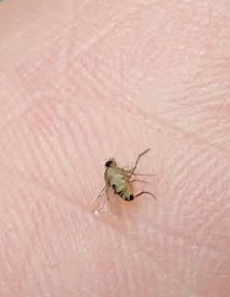Hello, all!
This is Brooke here! If you don’t already know, I’m the editor of this blog and will be filling in for Olivia while she is off on a tour for her drum corps. I’ve got to warn you all that I’m not exactly as lucky as Olivia when it comes to finding wildlife, so we may be scraping the bottom of the barrel here. But hopefully, I can get you guys thinking a little bit about the smaller things in life!
So, I just recently got back from an Army camp, and there weren’t too many animals lounging around on base. But I was lucky enough to have several of these cute little guys fly into my eyes/mouth/ears every day.

Don’t worry, it’s not dead. Actually I lied. Yes, yes it is dead. But considering that these guys were a little overpopulated, and definitely not endangered, I decided to sacrifice it for the good of this website and so that it wouldn’t fly into my eyes.
Although there are many varieties of what is commonly known as “gnat”, all of them fall under the suborder Nematocerca in the order Diptera. One of the defining characteristics of the order Diptera is the two single wings design(as opposed to, for example, the four wing design of the dragonfly). One interesting fact about the two single wing design is that it actually evolved from the four wing design. Although there is always speculation about how evolution progresses, a large number of biologists would agree that the evolution of the two single wing design resulted from a developmental mutation involving the amount of a certain hormone being released during embryonic development.
But, I digress. “Gnats” are typically found in warm, humid environments. Depending on the variety, the literature will tell you that they eat things such as fungus, moss, nectar, etc. However, like many other animals, they have begun to adapt to human habitation. I personally have observed them to dine on things such as dead animals, human food, and sweat.
As annoying as they may be, gnats play an important part in the ecosystem, serving as food for other animals such as birds, bats, and even larger insects. They can also serve as pollinators.
Well, that’s about all I have for you all today. I would say, “save the gnats”, but I honestly don’t think we could get rid of them if we wanted to. So how about “appreciate the gnats?” Yeah, I like the sound of that. I’ll talk to Olivia about putting that one on one of her little T shirts. Best-seller?
Yours in animal conservation,
Brooke Kowalski
Hello to every , because I am genuinely eager of reading this
webpage’s post to be updated on a regular basis. It carries good
stuff.
LikeLiked by 1 person
Thank you so much! We are glad you enjoyed reading! We are going to have more engaging posts coming up soon, so do stay alert!
LikeLiked by 1 person
Hey there! Someone in my Facebook group shared this website with us so I came to look it over.
I’m definitely loving the information. I’m bookmarking and
will be tweeting this to my followers! Outstanding blog and terrific style and design.
LikeLiked by 1 person
Thank you so much for your feedback! We are glad you enjoyed!
LikeLike
Enjoyed reading through this, very good stuff, regards.
LikeLiked by 1 person
Thank you so much for your feedback! We are glad you enjoyed!
LikeLike